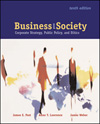Post discusses vital new themes in modern business and management education such as the
growth of the Internet. End of chapter material contains a list of websites to enrich course information. Many text references also include related websites. Managing across business functions: Post presents examples of companies that have successfully
managed social issues across business functions in a strategic, stakeholder-oriented manner. Team learning: Post incorporates team process features into each chapter and includes special
team exercises. Implementation strategies: Post articulates how managers can create strategies that integrate
stakeholder interests, respect personal values, support community development while also being
economically sound and successful. Chapter 18: Technology and Business Responsibility examines the complex relationship between
science, technology and society. Chapter 2: Strategic Management of Stakeholder Relations examines the strategic action model
that businesses can use in dealing with public issues. Cases: Each chapter includes real life examples of business behavior and a discussion case
appropriate for student assignments. Nine or ten full-length case studies, written to provide rich
discussion material, present a variety of opportunities for instructors to connect topics raised in
several individual chapters. Five Forces Model: Not simply a compendium of information and ideas, Post puts forth the view
that in a global community traditional buffers against change no longer protect businesses from the
forces of : The corporation in society; The social and ethical environment; The global society, The
natural environment and Responding to stakeholders. | 



 2002 McGraw-Hill Higher Education
2002 McGraw-Hill Higher Education